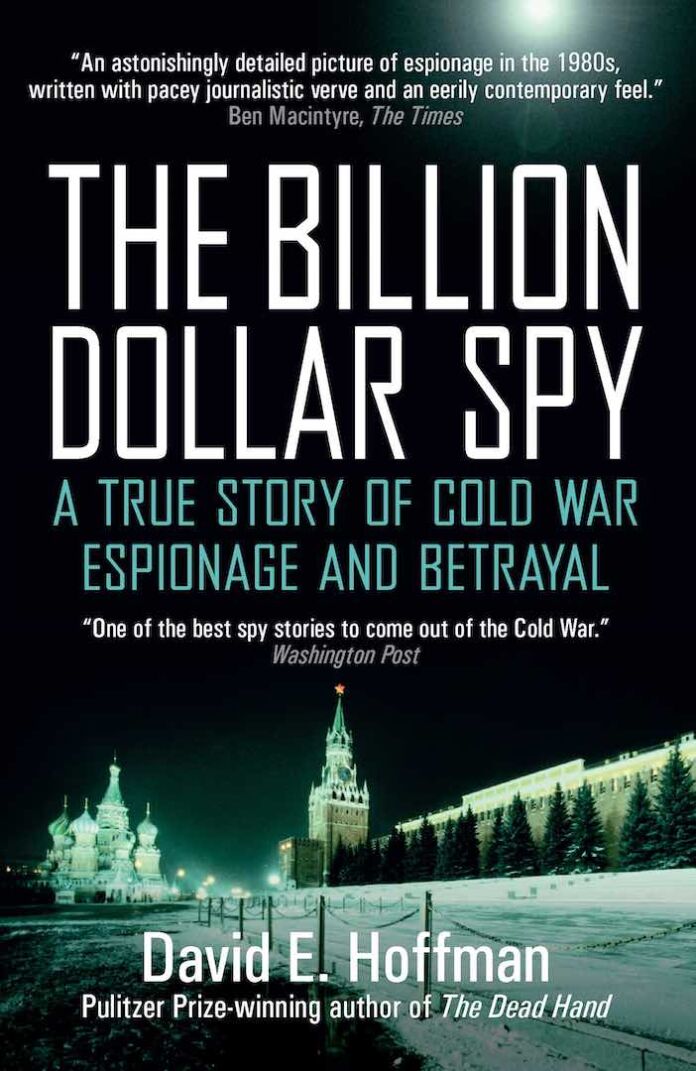Title: The Billion Dollar Spy
Author: David E. Hoffman
Publisher: Icon Books
Genre: Cold War Espionage, True Accounts
First Publication: 2015
Language: English
Book Summary: The Billion Dollar Spy by David E. Hoffman
January, 1977. While the chief of the CIA’s Moscow station fills his gas tank, a stranger drops a note into the car.
In the years that followed, that stranger, Adolf Tolkachev, became one of the West’s most valuable spies. At enormous risk Tolkachev and his handlers conducted clandestine meetings across Moscow, using spy cameras, props, and private codes to elude the KGB in its own backyard – until a shocking betrayal put them all at risk.
Drawing on previously classified CIA documents and interviews with first-hand participants, The Billion Dollar Spy is a brilliant feat of reporting and a riveting true story from the final years of the Cold War.
Book Review: The Billion Dollar Spy by David E. Hoffman
Published in 2015, The Billion Dollar Spy is an immersive nonfiction thriller that tells the incredible true story of the CIA’s most valuable Soviet asset of the Cold War era. Written by Pulitzer Prize-winning journalist David E. Hoffman, this page-turning spy biography brings to light classified details of one of the most important intelligence coups in US history.
Hoffman gained unprecedented access to declassified documents and key figures involved to reconstruct the riveting saga of Adolf Tolkachev, a Soviet scientist who spied for the United States from the 1970s until his death in 1986. Tolkachev was an engineer who worked in a top-secret design laboratory. He was an expert in airborne radar and worked very deep inside the Soviet military apparatus. Through meticulous research and vivid storytelling, Hoffman transports readers back in time to experience the high-stakes cat-and-mouse game that Tolkachev played with the KGB as he risked everything to provide top-secret information to the CIA.
The book opens by introducing Tolkachev, an electronic engineer working at a top-secret Soviet military installation outside Moscow in the 1970s. Driven by discontent with the oppressive Soviet system and desire to promote world peace, he makes contact with the CIA through anonymous letters. Thus begins a years-long covert relationship that yields a treasure trove of intelligence on Soviet weapons technology, some of which the KGB was unaware had been compromised.
Hoffman skillfully captures the nuanced psychology of Tolkachev, portraying him as a complex figure motivated by idealism yet also ambition and desire for prestige in spying. Through documents and firsthand accounts, the reader gains insight into what drove Tolkachev to undertake the immense personal risks of being a mole, even as his actions remained mysterious to his family and coworkers. His motivations feel profoundly human despite the extreme stakes.
Meanwhile, the CIA case officers who directed Tolkachev – collectively referred to as “Ramon” – receive in-depth examination. Hoffman reconstructs their ingenious spy craft methods for secretly meeting Tolkachev in dead-drops and brush passes, from disguise to handling one-time pads for encrypted messages. The operations were handled meticulously yet often nearly went wrong, keeping readers on the edge of their seats.
Tolkachev’s rolls of microfilm provided America with invaluable strategic advantage during the Cold War’s most perilous years, exposing everything from new Soviet bomber designs to weaknesses in their air defense systems. Using formerly classified documents, Hoffman explains the profound impacts on US policy and defense programs. At the same time, the KGB was always hunting for the mole, conducting surveillance on all CIA agents in search of the link.
Woven throughout the geopolitical backdrop is the human drama. Tolkachev lived a constant double life, torn between family and fatherland yet unable to share his secret work even with his wife. Meanwhile, the CIA officers struggled with distance and secrecy from their handler roles. In one heart-wrenching scene, a case officer’s attempt to visit Tolkachev’s family without revealing their connection highlights the personal toll of their dangerous work.
Tragically, in 1986 the KGB finally closes in on Tolkachev. In a nail-biting finale, Hoffman chronicles the spy’s final risky dead-drops and the KGB’s surveillance catch-up before they discover his identity. The epilogue explores the aftermath, from changed US-Russia diplomatic relations to the enduring secrecy surrounding Tolkachev even after the Cold War’s end. Throughout, Hoffman handles potentially dry historical and technical subjects with pace and resonance.
What makes The Billion Dollar Spy such a tour de force is Hoffman’s uncanny ability to imbue true events with all the pulse-pounding suspense of a masterful novel. From first page to last, he commands rapt attention through intimate character portraits, globetrotting locales and propulsive tension that seems to defy the known conclusion. The book has set a new high bar for the nonfiction spy genre.
In summary, David E. Hoffman has produced a nonfiction spy thriller that will enthrall intelligence aficionados and casual readers alike with its brilliant reconstruction of an espionage Cold War epic. Bringing to light secrets kept hidden for decades, The Billion Dollar Spy shines a revealing light on sacrifice, loyalty and geopolitical upheaval through the lens of one man’s courageous betrayal. With its breakneck pacing, vivid storytelling and profound research, it stands out as a true tour de force of narrative nonfiction. This landmark work has ensured that Adolf Tolkachev’s legacy will finally receive the recognition it deserves.





